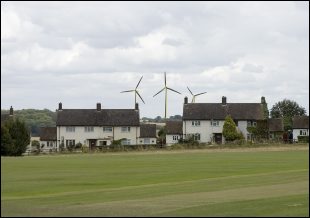| Wind Watch is a registered educational charity, founded in 2005. |
Windfarm complaint to Advertising Authority
Share:
Translate: FROM English | TO English
Translate: FROM English | TO English
The developer of a proposed wind farm has complained to the Advertising Standards Authority (ASA).
RH Bott and Sons, which proposes to erect three 400ft high turbines on land on High Elms Lane between Benington, Aston and Watton-at-Stone, made the complaint about the Stop Benington Wind Farm (SBWF) campaign leaflet because it was concerned people would be misled by some of the information in it.
It believed the computer generated images in the leaflet “did not represent the visual perception of the proposed wind farm” and that the claim that “the noise they emit day and night could cause distress to hundreds of residents” could not be validated because the proposed development conforms to Government guidelines laid down for wind farm noise levels.

The controversial image
ASA have since come to the conclusion that the pictures were acceptable and that claims of noise disturbance were untruthful and unsubstantiated.
Developer Andrew Bott said: “I am glad that the statement about noise was found to be untruthful because we know the wind turbines will meet the Government regulations on noise. I am not too disappointed by the judgment on the pictures because they were not very life-like and most people will realise that if the turbines are built they will not look anything like that. Also the visual impact is subjective – some people think the structures are wonderful, others do not.”
Commenting on the ASA complaint, Rowan O’Duffy, a spokesman for SBWF, said: “Complaining to the ASA is a common tactic used by wind turbine developers. We can only assume it is meant to put pressure on their opponents but in this case it has proved that the visual impact on the landscape as we have shown it is correct.”
RH Bott and Sons is due to submit a planning application to East Herts District Council within the next two weeks.
8 May 2008
This article is the work of the source indicated. Any opinions expressed in it are not necessarily those of National Wind Watch.
The copyright of this article resides with the author or publisher indicated. As part of its noncommercial educational effort to present the environmental, social, scientific, and economic issues of large-scale wind power development to a global audience seeking such information, National Wind Watch endeavors to observe “fair use” as provided for in section 107 of U.S. Copyright Law and similar “fair dealing” provisions of the copyright laws of other nations. Send requests to excerpt, general inquiries, and comments via e-mail.
| Wind Watch relies entirely on User Funding |
 (via Stripe) |
 (via Paypal) |